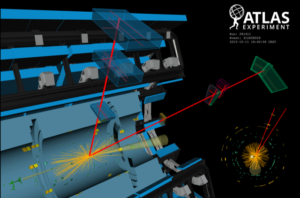With a public event at De Balie in Amsterdam and a laser show on the highest data tower at Amsterdam Science Park, Nikhef will celebrate the tenth anniversary of the Higgs particle in early July. Nikhef played an important role in the discovery of that particle, which is crucial for physics, in 2012.

Starting Friday evening, July 1, an animation of particle collisions will be visible on the west facade of the Digital Realty building next to Nikhef at Amsterdam Science Park for several evenings after dusk. The show will remain visible through the night of July 4th, ten years to the day since the discovery was announced at CERN.
Public event
On Sunday, July 3rd, from 15-17hrs, Nikhef organises a public event (tickets here) about particle research with lectures and music at debate center De Balie in Amsterdam. Performing there will be singer-songwriter Bonnie Kemplay, granddaughter of Peter Higgs, the Scottish theorist who predicted the existence of a Higgs particle in the 1960s. In 2013, he was awarded a Nobel Prize in physics for this, along with Belgian co-theoretician François Englert.
In 2012, the ATLAS experiment and the CMS experiment at CERN announced that they had found a previously unknown particle, which almost certainly had to be a Higgs particle. In 1964, Peter Higgs and others proposed a new mechanism that explained why particles have mass. Until then, the theory could only deal with particles without mass, such as photons.
Mass mechanism
Higgs predicted that the new mass mechanism must also involve a new particle. This idea led to a long quest in physics to find the Higgs particle in particle experiments. First the LEP accelerator was built at CERN and later the Large Hadron Collider, a circular accelerator with a circumference of 27 kilometers.
That LHC delivered proton collisions in which occasional glimpses of a new particle were found. By 2012, after years of measuring, the two large detectors at CERN had collected enough of such glimpses to conclude that there was a new particle. That particle had the same properties that Higgs had foreseen decades earlier.
Door opened
The discovery of the Higgs particle in 2012 was proof for physicists that there is indeed a universal influence that gives particles mass, the so-called Higgs field. Since then, particle physicists have been studying with measurements how that unknown Higgs field works in reality and what its properties are exactly.
“It’s like a door had opened,” says Nikhef director Stan Bentvelsen in one of the interviews with Higgs hunters from then and now on the Nikhef website. At the time, the discovery of the Higgs particle was the crowning glory of a quest spanning decades, but more importantly, it was the gateway to a lot of new particle research. “The research field shifted from hunting to exploring,” Bentvelsen said.
Central role
Nikhef was involved in the hunt for the Higgs from the outset, first at LEP and later at the LHC at CERN in Geneva, where the Dutch helped build the ATLAS detector, the largest particle detector in the world.
Nikhef also has an intensive presence in the Higgs research since 2012, which focuses on the central role of the Higgs field in the particle world. Among other things, researchers are working on measuring the relationships between the Higgs particle and various quarks, which in principle should be proportional to their mass. So far, that indeed seems to be the case.
Large Hadron Collider
The interaction of Higgs particles among themselves is also an important research topic, as this self-coupling may have played a role during the creation of the universe itself at the Big Bang.
The increasingly powerful proton collisions in the LHC accelerator at CERN play an important role in this research. That accelerator, after a period of three years of maintenance and improvements, turns back on with more collision energy than ever on July 5, the day after the 10th anniversary of the Higgs particle.
More information from CERN: